PRIZ and STAN are traditional New York City graffiti writers whose tags and pieces once graced the interiors and exteriors of Manhattan's uptown Broadway 1, 2 and 3 subway lines. While using homemade Flo Master filled Pilots, IRT master keys, sleeve job paper label Krylon and Grandma's Kodak 126 camera, they infiltrated the city's dimly lit underbelly from the late 1970s to the mid 1980s under these names and other pseudonyms in the ultimate game of tag.
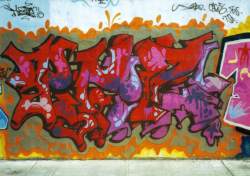 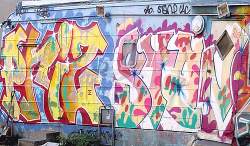 |
| It's 2007. How long have you been writing? Who or what got you started writing? How did you get your name and aliases? |
PRIZ: I started writing in 1979 in discreet and inconspicuous places at first, freely on unobserved neighborhood buildings and then on desolate subway station walls along Broadway.
I was hanging out at a writers' corner in my school cafeteria and benching at select subway stations like 96th Street and 125th Street, where loners and introverts with some hidden talents converged and socialized. My neighborhood on the upper Westside of Manhattan was also a backdrop for elegant style signatures and distinctive masterpieces which were plastered on handball courts, park walls and school playgrounds by dynamic cats like JEAN 13, BILLROCK, REVOLT and DOZE to name a few.
During my inept period as a novice, I experimented with contours, indecipherable logograms in my blackbooks quite frequently. I habitually wrote a variety of names i.e., RM/MR, SWAN 1, TLD and PRIS, but when I came across my math tutor's Letraset lettering book, which had a wide selection of numerical and alphabetical commercial lettering styles, I vigorously dissected words such as PRIZMA/PRIZM, PRISMA/PRISM, but because I could not write them quickly enough while motioning trains and hitting streets, I finally settled with the bold simplicity of the tag name PRIZ.
STAN: I started bombing in late 1979 till 1984. When I was in high school a classmate of mine named Junior used to hit the Broadway #1 line whenever he got the chance. One day I ran into him while he was sketching in his notebook, and what he was drawing caught my eye. I asked what he was doing and he stated that he was getting his outline ready to go paint that night. When the sketch was complete it looked pretty cool. I had been drawing for a while and I liked to draw the Superman "S" into my name which I thought was def until I saw his finished outline. This was my first taste of graff that has stayed with me to date.
This same classmate and I were into wrestling and my signature move was adopted from a wrestler named "Stan the Man" and the name stuck with me. |
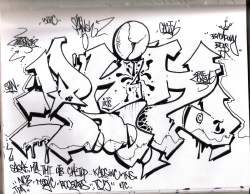 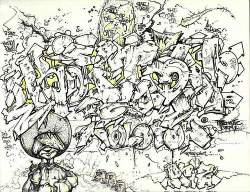 |
| Out of all the crews you represent, as partners which crews do you mutually hit up presently? |
PRIZ: TSF/TS5 "The Spanish 5ive" - VICE PREZ, CAC/CACITY "Cool Art Creators/Cool Artistic Creativity" - RECRUITER.
STAN: I am the PREZ of "The Spanish 5ive" |
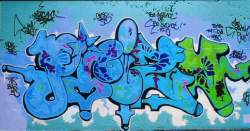 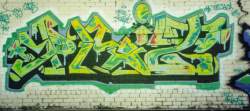 |
| Today many writers are involved in trends like designing tattoos, video games and apparel. Have you thought about branching out into other venues? |
PRIZ: I am venturing into more media print as well as period piece set designs for television and movies.
STAN: At the moment I am into creating web sites, photography and filming videos. |
 |
| What is it about writing/piecing/bombing that keeps you motivated after all these years? |
PRIZ: It could be any one thing or several factors that motivates me. The smell of the subway tracks on a hot summer afternoon, the distant rumbling of an express train, a song, old friends or good times long passed. In my opinion, a true writer never abandons the art of tagging and piecing or tires of seeing his name up. I'd like to think that's the way I still do it.
STAN: Broadway had a lot of good writers on the outsides and insides in the '80s. The competitiveness between writers is what has motivated me through the years. |
 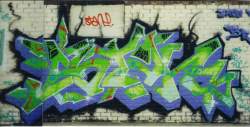 |
| What excites you and what frustrates you most about graff? |
PRIZ: What excites me about graff is that it's something that has always challenged and kept me on the edge creatively. This encompassed rival crews, cops, and the MTA's buff. If style and skill were easily handed out then cats like me wouldn't work so hard to obtain it. Catching wreck and getting rec.
In this game, I can still remain a nonconformist and true to the essence of a long, almost forgotten decade of train art that many participated in and have received no notoriety for but helped plant the seed. The multicolored blazing burners, checkerboard backgrounds, sleek sinister simples and pin tipped Pentel purple homemade mops. There is no substitute for any of this.
What frustrates me is how the media portrays graffiti and continues to depict the writer/graffiti artist. Speaking from experience, the reporter will misquote you and distort the facts to make their point or counterpoint for the story. Figuratively painting us into a corner and portraying us as old school, uneducated hoods with a limited vocabulary. Pitting David against this huge, undefeated monopolized MTA Goliath and their Cerberus (the Vandal Squad) to infiltrate, intimidate and vanquish us. All this is to give the tax paying straphangers a sense of comfort so that they feel in control and sleep peacefully at night..... Keep dreaming.
STAN: What excites me today about graffiti is the new colors and large-scale 3D style murals that seem to be on the rise today with the newer writers. The artwork on the international subway cars are remnants of my past and seeing the styles reminds me of where we all came from. What frustrated me is the politics involved in painting in certain places/areas along with who paints in what spot. Coming up, we just painted regardless of the spot or the people, that was the point of it all. |
 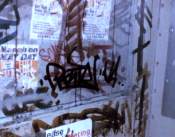 |
| What do you think about the relationship of graffiti to the current commercialized art world? |
PRIZ: The relationship between graffiti and the commercialized art world is mixed to me. Metaphorically speaking it reminds me of the stepchild that lives under the same roof but is not allowed to participate and break bread with their family. Commercialized graff is a generic, watered down, nonflammable art form -- though others may disagree -- the rawness is lacking and is no longer highly toxic or lawless.
It's almost comical in commercials and on the side of buses when it comes to media advertising. Though graff has strong roots in commercial/visual communications and comic book lettering, it's generally censored unless used in an crime-ridden, ghetto platform. If graff appears in the American press in a nonthreatening manner, it is still questioned and discarded because the graffitist is docile and creates legal works, but when threatened the liberal majority demands an immediate lynching.
STAN: The styles are much more polished, larger in scale and are strongly influenced by commercial art, though graff is still rarely mentioned or accepted when it comes to Hip Hop. The European writers have brought out a lot of new versions of letter graff styles with their grandiose, surreal murals and their eccentric use of color. Which is still regrettably more accepted in their countries than it is where the art form originated in New York. |
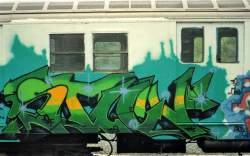 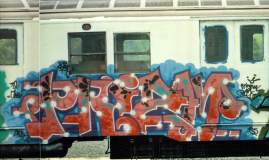 ca. 1990s ca. 1990s |
| Where do you think lettering styles are headed? And how has your personal style progressed? |
PRIZ: They have come a long way from the huge metal canvases of yesterday and the turf war between the MTA and the writers over the trains. The style today has taken a backseat to the muralist backgrounds and caricatures. It has become more of an offshoot of graphic art that the public once categorized as vandalism when it swept into the gloomy subway stations, where writers had a dialogue by leaving their mark. Today the styles are more refined, airbrush fades with crisp and clean design elements but the pieces are smaller in stature in comparison to the large scale of colorful lettering on the outside of yesteryear's trains. It's not about the mystique of one's name, it's about the mystique of the background and characters where the name is applied. The high sense of excitement that had become so characteristic of subway art is lost forever.
I've used the old lettering with the pulsing sensation, which was affective when the train was in motion and added the cacophony of new paint colors and new pristine caps. These old techniques with the new has refined my own individual designs and letter styles as well as evolved me as a more effective writer/artist on any surface. My pieces reflect a broader method though the system of master teaching pupil is absent. However, my speed of execution is swifter.
STAN: The way I see it, back then everyone was not a writer. It was more underground. Today, people just start writing to travel the world. Back in the days, the subway letter style traveled from one area to another and was never isolated to a particular spot or borough. Today's writer along with their international crews and their individual styles do travel worldwide.
My personal style is a marriage of old and new. Colors, forms and letters vary from one era to another but the gist of it is relative to all. I pick and choose what I personally like from all art forms and reinvent it to my vision. |
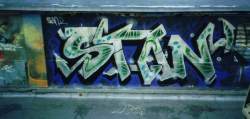 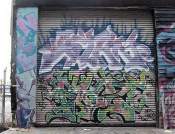 |
| How do you feel about glass carving and the use of acid on subway windows to get "ups"? |
PRIZ: It's a different approach to fame but you can still get arrested. It is beneficial to the new generation and the payoff when they see themselves up. There is no interaction of form in the crude carvings. I couldn't decipher any stylistic characteristics distinctive enough to be identified with any new upcoming graffiti era or generation. Though your tags are still visible to your peers, especially with the acid tags. If I were to chose between either one, I choose neither, I prefer to continue writing with ink in the trains interiors though they will eventually get scrubbed. It may not be as permanent today in comparison, but I would just have to make the ink more potent or hit more difficult cleaning spots. I don't want to get lost in the crowd or become part of it. New ideas and urban crazes are always being created along the tracks, these two do not inject any sense of excitement in me. In my opinion, I do not see this as a revolutionary development of subway graffiti.
STAN: It is just another way for the younger graff generation to get fame, but the carvings remind me of the school desks while I was in high school. There is no flair to the carvings, it's all a boxy, lifeless action. As for acid tags, they are just reminders of the true ink tag from our past burned into a window. |
 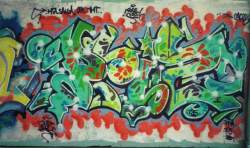 |
| How important is style and originality to both of you? |
PRIZ: The joy of creating your own style is essential to prove it can be done and to make art from a simple alphabet. It is your own voice, your own look and it also says "I exist... Check me out." Creating new ideas and expanding on them while paying homage to the old. Though there are different forms, there will always be biters at a ferocious rate, so you have to bend and stretch the letters into different shapes and sizes to achieve the desired expression, and that is expected from new jacks to reach the next level. But when it comes down to it, every style is as unique as a fingerprint.
STAN: Graffiti back in my day was all about style, lettering was the key difference between having a def or toy style. That is what made PRIZ and me and the rest of the TSF members as well as other crews stand out. |
 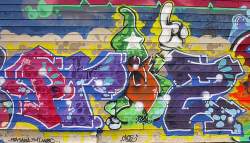 |
| Is writing still worth the risk today? |
PRIZ: The urge will always be there, the reward however is different. The risk is inevitable and the dangers are quite real with the NYCTA's domain. The journey's excitement goes hand in hand with the overlapping letters and the razorwire.
STAN: Everything related to graffiti is a risk regardless of the era. |
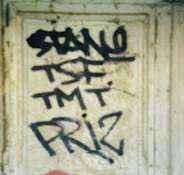  |
| Explain what you find unique about painting with a partner versus going solo? |
PRIZ: With a fully down partner in crime like STAN, you have unspoken teamwork. Each individual has a specialty, one sketches out the subway car in his blackbook, one plans out the paints for each car and you go and rack the paint and caps. You go on mutual riding ventures that can be fun but also an occupational hazard. You have each other's backs. If you have good chemistry and a common goal, not only do you complement one another, you can be unstoppable. Going solo has its advantages in stealth, speed and anonymity. Because of this you carry a quiet dignity and a roll of quarters in your pocket.
STAN: When I met PRIZ in 1982 and put him down with TSF, I saw PRIZ as another writer who shared the same passion for bombing trains and getting up as I did. Partners in general have unwritten rules that only they comprehend along with balls and skills. My first partner DONE and I had a lot of memorable times in the #1 tunnels. In going solo, you had to be a lot more careful, but if everyone was busy on the weekend and couldn't paint, you went down to the tracks alone and did your thing. |
 |
| You state the zenith of style is the letter in the piece. What about the handwritten tag? |
PRIZ: In my opinion the piece/burner will always take precedence over the tag and the throw up in the graffiti structure. The hand style is the simplest and purest form, the signature is the genesis where everything is created from. With the tag you can't hide the letters in colors, fades or designs. However, the throwies were once markers on subway cars of the writer's upcoming piece as well as being used to purposely background people. Finally, they all contribute to getting up and getting your name across.
STAN: The throw up and the tag serve a purpose but I personally prefer the piece above the rest. The throw up and the tag are always used for bombing, but the piece is where your true talent is shown. |
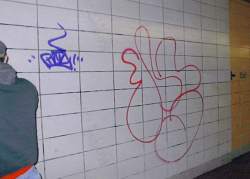 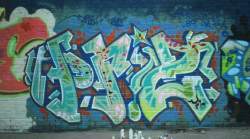 |
| How did life differ for you after the trains? Did you ever quit? And what did you do afterwards? |
PRIZ: I've improved because I've had an opportunity to paint on all types of surfaces as well as in different boroughs. I quit about late 1986 to pursue other avenues on art/typography. I fell off as far as piecing but not writing altogether. By 1989, the once white elephants (R-17) on Broadway had been replaced by the stainless steel Canadian Bombardiers (R-62) and the Spanish 5ive crew had disbanded. By 1990, I came back repping "CAC" hard and painting a lot of illegal walls under the 238th Street bridge in the Bronx.
STAN: I retired by 1984 and by 2000 I met up with PRIZ after many years of painting and airbrushing canvas. I decided to reinstate The Spanish 5ive for the new millennium. We have been going strong ever since. |
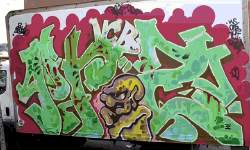  |
| How important is being old school and what does it signify to you? |
PRIZ: It's what I am, love it or leave it. I did a handful of pieces, hit up insides in the IRTs and a few BMTs between the late '70s to the early '80s. Whether other cats saw me up or not is all insignificant to me. I never minced words nor did I ever set out or claim to be a king, trailblazer, pioneer or having mad ups like the majority of these yo-yos that I met in the late '80s. The significance is in my present work, the knowledge and experience I've obtained after many years. This speaks volumes in itself. My opinion, old school to me signifies being there, experiencing, documenting, living, breathing and being it. I have taken a piece of my history and brought it into today after years of molding and manipulating it to who I am now.
STAN: Learning from the past and cherishing it, not disregarding the little details. I am old school, along with all the writers that I came up with. I have my own interpretation of style and have infused some of the newer forms to suite my needs but I cling to what I know. |
  |
| Is there any one you would like to honorably mention? |
We would like to give a shout out to these cats who we've met and painted side by side with: DISCO 3YB, PAID 3, RAB CAC, RUN MBT, "RIP" WASP 1, YAZ-ONE CAC, DONE 101 TSF, FDT56 SALSA, CLYDE, SNAKE ONE, FLINT 707, MATCH 2 TSF, SUPA 62 TSF, RS and TROY.
And a special thank you to Susan for giving us an opportunity to tell our history, and Mari for the in depth questions, time and patience. |
| NEXT PAGE |












 ca. 1990s
ca. 1990s














 Featured Artists
Featured Artists Art Crimes Front Page
Art Crimes Front Page